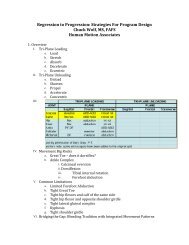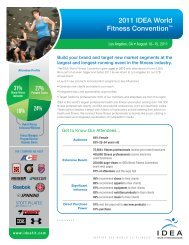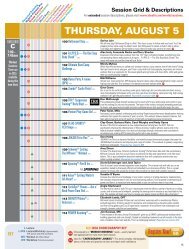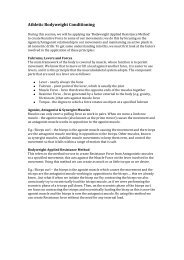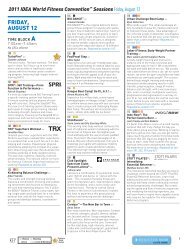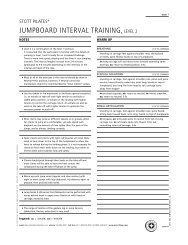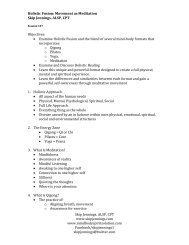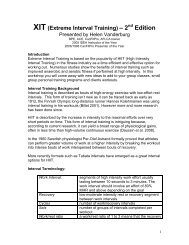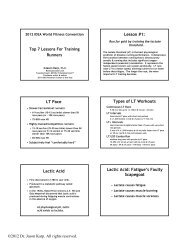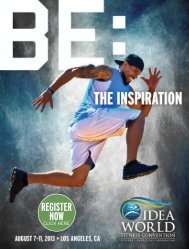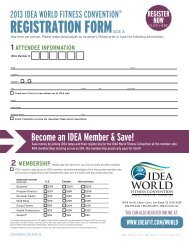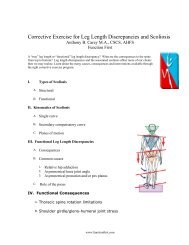ACSM Health & Fitness Summit - Idea
ACSM Health & Fitness Summit - Idea
ACSM Health & Fitness Summit - Idea
You also want an ePaper? Increase the reach of your titles
YUMPU automatically turns print PDFs into web optimized ePapers that Google loves.
IDEA Personal Trainer Institute<br />
March 2, 2013<br />
Practical Exercises for Sedentary Seniors (Session #346)<br />
Mary Yoke, M.A., M.M.<br />
(mmyoke@indiana.edu)<br />
This workshop provides practical information geared to help you make a difference in the lives of<br />
deconditioned Seniors. As our population ages, fitness professionals continue to need practical<br />
knowledge of specific exercises and techniques, especially for very deconditioned older<br />
participants and those with arthritis and/or osteoporosis. In this session, you’ll learn and practice<br />
a multitude of chair and balance exercises appropriate for frail and sedentary elderly clients.<br />
At the end of this session, participants will be able to:<br />
create a variety of Level One exercises for seniors<br />
identify characteristics of aging that affect exercise programming<br />
understand issues important for people exercising with arthritis and/or<br />
osteoporosis<br />
I. Characteristics of Aging That Affect Exercise Programming<br />
Decreased maximal heart rate<br />
Decreased VO2 max<br />
Increased blood pressure<br />
Increased use of medications<br />
Slower reaction time<br />
Progressive loss of bone mass (osteoporosis)<br />
Increased % body fat (creeping obesity)<br />
Loss of muscle strength due to sarcopenia<br />
Declining flexibility<br />
Increased tendency toward dehydration<br />
Increased susceptibility to soreness and injury<br />
II. Benefits of Exercise for Seniors<br />
Increased strength with mild to moderate hypertrophy (Fiatarone et al, 1994)<br />
Increased bone density<br />
Improvements in joint range of motion<br />
Improved balance<br />
Increased lean body mass and decreased % body fat<br />
Improved glucose tolerance<br />
Improved cholesterol status<br />
Decreased stress<br />
Decreased risk of dementia (Abbott et al, 2004)<br />
Enhanced sense of well-being<br />
Improved ability to carry out activities of daily living<br />
III. <strong>ACSM</strong> Guidelines for Older Adults (2010)<br />
A. Cardiorespiratory <strong>Fitness</strong><br />
Walking is an excellent choice for many seniors; water exercise and stationary cycling<br />
are good for those who must limit weight-bearing exercise.<br />
Any modality that does not impose excessive orthopedic stress.
The activity should be accessible, convenient, and enjoyable.<br />
Intensity levels should start low (possibly as low as 40% of HRR).<br />
Avoid using age-predicted heart rates (e.g. 220 – age) due to HR variability in older<br />
adults and increased risk of CHD. Instead, use rate of perceived exertion (RPE).<br />
Shorter bouts of exercise (e.g., 10 minutes) may be preferable.<br />
B. Resistance Training<br />
Carefully supervise the first several sessions.<br />
Begin with minimal resistance.<br />
Perform one set of 8-10 exercises that involves all major muscle groups.<br />
Perform 10-15 repetitions at an RPE rating of 12-13 (somewhat hard).<br />
Perform all exercises within a pain-free range of motion.<br />
Machines are preferable to free weights for most older adults.<br />
C. Flexibility Training<br />
Provide a well-rounded program of stretching and maintain range of motion of all joints.<br />
Consider devoting an entire session to flexibility for beginner older adult exercisers.<br />
D. Balance Training<br />
<br />
<br />
<br />
<br />
<br />
2-3 days per week<br />
Use progressively difficult postures that gradually reduce the base of support<br />
Use dynamic movements that perturb the enter of gravity<br />
Train postural muscle groups (e.g. lower leg muscles)<br />
Reduce sensory input<br />
IV. Osteoarthritis (Degenerative Joint Disease)<br />
Approximately 27 million adults have osteoarthritis, with the knee and the joints<br />
of the hand being the most common sites. It is caused by a wearing away of the<br />
articular cartilage, leading to bone-on-bone abrasion—resulting in joint pain and<br />
stiffness. Typically, there are cycles of more and less pain. Exercise and physical<br />
activity have been shown to be very effective in managing osteoarthritis pain.<br />
Strategies for exercising with osteoarthritis include:<br />
Start with short bouts of low-intensity, low or non-impact exercise.<br />
Avoid higher levels of exercise on day when arthritis pain is severe.<br />
Stretch daily, if possible, always staying within a pain-free range of motion. If possible,<br />
gently move every joint every day.<br />
Perform strengthening exercises twice a week for unaffected joints.<br />
Strengthen affected joints on days when relatively pain-free.<br />
Isometric exercise may be preferable.<br />
Water exercise can be very beneficial.<br />
Be gentle with any joint that is hot or swollen.<br />
Stop any exercise that causes pain.<br />
V. Osteoporosis<br />
Osteoporosis is a condition of abnormally reduced bone density, leading to<br />
fragile, porous bones and the increased risk of bone fractures.<br />
Exercise recommendations include:<br />
Avoid all spinal flexion, especially cervical spinal flexion; perform as many exercises as<br />
possible in an upright position.<br />
Spinal extension may be beneficial in reducing the risk of vertebral fractures (Sinaki et al,<br />
1996).<br />
If the client is pain-free, it is appropriate to recommend aerobic weight-bearing activity<br />
4x/week, resistance training 2-3x/week, and flexibility training 5-7x/week.<br />
Perform resistance training with the load directed over the long axis of the bone.<br />
Include balance training and functional exercises related to activities of daily living.
Avoid high-impact activities and any activities with an increased risk of falling, such as<br />
crossover stepping, step aerobics, skating, and trampolines.<br />
VI. Motivational Techniques for the Elderly<br />
Be aware of hearing difficulties: face participants, speak clearly with appropriate volume,<br />
control background noise.<br />
Avoid patronizing language.<br />
Regularly bring in new facts about the benefits of exercise and physical activity.<br />
Play music they enjoy. Ask for their favorites.<br />
Create an atmosphere of fun.<br />
Include introductions<br />
Encourage participants to come early and stay late for social interaction with each other.<br />
Show a genuine and sincere interest in each participant.<br />
VII. Exercise Recommendations for Sedentary Seniors<br />
Avoid doing too much, too soon.<br />
Focus on safety.<br />
Do exercises standing whenever possible.<br />
Use varying movement patterns and functional exercises.<br />
Level 1 2 3 4 5 6 7,etc.<br />
Very safe<br />
High risk, controversial<br />
Appropriate for almost everyone<br />
Appropriate only for the very fit<br />
Stable and supported<br />
Unstable, high balance and core stability challenge<br />
Single joint, muscle isolation<br />
Multi-joint, multi-muscle, multi-planar<br />
VIII. Chair Exercise<br />
Challenge yourself to come up with a variety of Level One exercises. Level One<br />
exercises are very safe, require little skill, and are appropriate for almost everyone.<br />
They are generally performed with the body in a very stable position. Consider<br />
exercises from the weightroom, Pilates, yoga, etc. Equipment might include dumbbells,<br />
barbell, elastic tubing or bands, small balls, medicine balls, Osteoballs, Pilates circle,<br />
etc.<br />
Warm-up<br />
Cardiorespiratory Training<br />
Muscle Conditioning Exercises<br />
Balance Exercises<br />
Flexibility Exercises<br />
Special category: Feel-good Exercises!<br />
IX. Feel-Good Exercise Examples (Chair)<br />
Sun breaths<br />
Shoulder (scapular) rolls performed backwards<br />
Posterior/anterior pelvic tilts, lateral pelvic tilts, pelvic circling<br />
Windshield wipers, progress into spinal twist, add shoulder circumduction<br />
Baby cobra (hands or elbows on seat back of chair in front)<br />
Ankle circles, figure 8’s, dorsiflexion/plantarflexion<br />
X. Hand and Wrist Exercises<br />
Play pretend piano<br />
Wrist circles, wrist figure 8’s
Make fists, open wide<br />
Extend and flex fingers (flexing only the last two joints of each finger); attempt to touch<br />
fingertips to palm of hand<br />
OK signs with each finger, stretching other fingers into extension with opposite hand<br />
Finger lifts with palm down on thigh or table<br />
Thumb touches to base of each finger<br />
Thumb circles and figure 8’s<br />
References and Resources:<br />
<br />
<br />
<br />
<br />
<br />
<br />
<br />
<br />
Abbott, R.D., White, L.R., Ross, G.W., Masaki, K.H., Curb, J.D., & Petrovich, H. (2004). Walking<br />
and dementia in physically capable elderly men. Journal of the American Medical Association, 292,<br />
1447-1453.<br />
Aerobics and <strong>Fitness</strong> Association of America (2009). Longevity Training for Seniors Workshop<br />
Outline. Sherman Oaks, CA: AFAA.<br />
American College of Sports Medicine (2010). <strong>ACSM</strong>’s guidelines for exercise testing and<br />
prescription (8 th ed.). Baltimore: Lippincott Williams & Wilkins.<br />
American Council on Exercise (2005). Exercise for Older Adults, 2 nd ed. Champaign, IL: Human<br />
Kinetics Publishers.<br />
American Senior <strong>Fitness</strong> Association. www.seniorfitness.net<br />
Annesi, J.J. & Zimmerman, W. (2001). Group training for increased adherence to regular physical<br />
activity. In J. Clark (Ed), Contemporary readings in senior personal training (pp. 59-61). New<br />
Smyrna Beach, FL: American Senior <strong>Fitness</strong> Association.<br />
BioMed Central Limited (2010). Walking linked to eased osteoarthritis. Medical News Today.<br />
Retrieved from http://www.medicalnewstoday.com/releases/179233.php.<br />
Best-Martini, E., Botenhagen-DiGenova, K.A. (2003). Exercise for Frail Elders. Champaign, IL:<br />
Human Kinetics Publishers.<br />
Brill, P.A. (2004). Functional <strong>Fitness</strong> for Older Adults. Champaign, IL: Human Kinetics Publishers.<br />
<br />
Center for Disease Control, (2012), www.cdc.gov/aging, retrieved, 8/16/2012.<br />
Chodzko-Zajko et al (2009). Exercise and physical activity for older adults. Medicine & Science in<br />
Sports & Exercise, 41:7, 1510-1530.<br />
Fiatarone, M.A., O’Neill, E.F., Ryan, N.D., Clements, K.M., Solares, G.R., Nelson, M.E., et al.<br />
(1994). Exercise training and nutritional supplementation for physical frailty in very elderly people.<br />
New England Journal of Medicine, 330, 1769-1775.<br />
<br />
<br />
<br />
<br />
Hooyman, N.R. and Kiyak, H.A. (2011). Social Gerontology: a Multi-disciplinary Perspective, 9 th<br />
ed. Boston, MA: Allyn & Bacon.<br />
International Council on Active Aging. www.icaa.cc<br />
Jones, C.J. and Rose, D.J. (2005). Physical Activity Instruction of Older Adults. Champaign, IL:<br />
Human Kinetics.<br />
Metcalfe, L., Lohman, T., Going, S., Houtkooper, L., et al. (2001). Prevention of Osteoporosis: the<br />
Bone, Estrogen, Strength Training (BEST) Study. <strong>ACSM</strong>’s <strong>Health</strong> & <strong>Fitness</strong> Journal, 5:3, 6-14.<br />
Nelson, M., Rejeski, W., Blair, S., Duncan, P., Judge, J., King, A., Macera, C., & Castaneda, C.<br />
Physical Activity and Public <strong>Health</strong> in Older Adults: Recommendations from the American College<br />
of Sports Medicine and the American Heart Association. (2007) Med Sci Sports Exerc, 39:8, 1435-<br />
1445.<br />
<br />
<br />
<br />
<br />
<br />
Rose, D.J. (2003). Fall Proof! A Comprehensive Balance and Mobility Training Program.<br />
Champaign, IL: Human Kinetics Publishers.<br />
Sinaki, M., Wollan, P.C., Scott, R.W., & Gelczer, R.K. (1996). Can strong back extensors prevent<br />
vertebral fractures in women with osteoporosis? Mayo Clinic Proceedings, 71, 951-956.<br />
Spirduso, W.W., Francis, K.L., MacRae, P.G. (2005). Physical Dimensions of Aging. Champaign,<br />
IL: Human Kinetics Publishers.<br />
Swezey, R.L., Swezey, A., Adams, J. (2000) Isometric progressive resistive exercise for<br />
osteoporosis. Journal of Rheumatology, vol. 27, no. 5., pp 1260-64.<br />
Van Norman, K.A. (2010). Exercise and Wellness for Older Adults: practical programming<br />
strategies, 2 nd ed. Champaign, IL: Human Kinetics Publishers.



